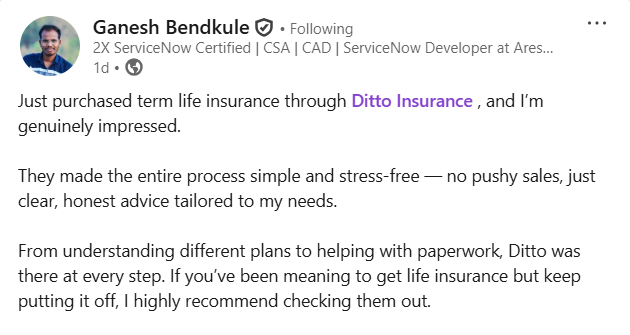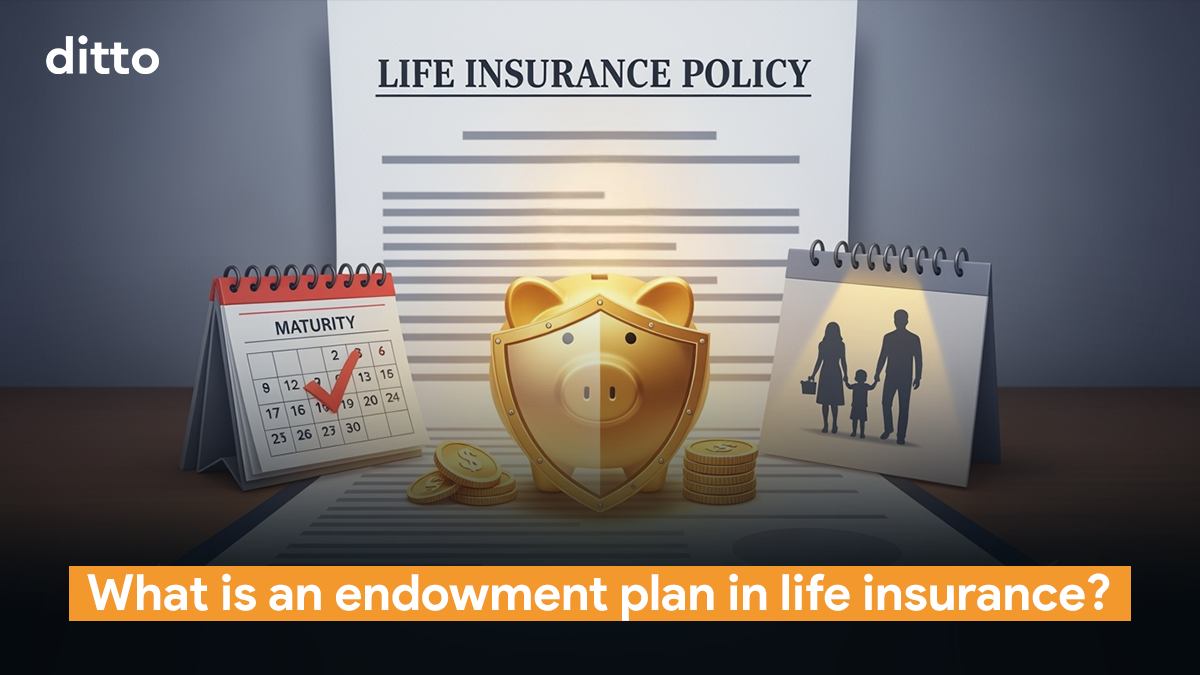| What is an Endowment Plan in Life Insurance? An endowment plan in life insurance is a dual-purpose policy that provides both life insurance coverage and a savings component. You receive a lump-sum payout if you survive till policy maturity, or your nominee receives the death benefit if you pass away during the term. Example: Suppose you purchase a 20-year endowment plan with a sum assured of ₹10 lakh. You’re covered for ₹10 lakh if you pass away at any time during those 20 years. If you survive till maturity, you receive a guaranteed sum plus bonuses (if any) at the end. |
The typical guaranteed returns on participating endowment plans in India are just 4% to 6% per annum, often lower than the average inflation rate (~6%). That means over a 15-25-year policy term, the real value of your “guaranteed returns” could actually shrink.
And yet, endowment plans are one of the most heavily sold life insurance products in the country. Why? Because they’re pitched as the perfect combo: “safe investment + life insurance.” No risk, money back, guaranteed maturity. What’s not to like?
But here’s the thing: most people buy these plans without truly understanding what they’re signing up for. That’s where Ditto comes in. We’re here to cut through the jargon, break down what these plans actually offer, and help you decide what works best, based on your financial goals, not someone else’s commission.
Not sure which riders you actually need? Talk to Ditto’s expert advisors today and get unbiased, personalised guidance - absolutely free.
What is an Endowment Plan?
In simple terms, an endowment plan is a life insurance policy that also acts like a savings plan. You pay premiums regularly, and at the end of the policy term, you either get a lump sum (if you're alive) or your family receives the payout (if you're not).
It’s essentially protection and savings combined.
Now, let’s clear the confusion around types of endowment plans.
Types of Endowment Policies
If you’ve ever googled this, you’ve probably come across terms like:
- Full Endowment
- Low-Cost Endowment
- Unitised With-Profit
- Non-Profit Endowment
The truth is that these terms are from the British actuarial/ insurance jargon and don’t accurately reflect how insurance works in India. Most websites, blogs, and insurance portals simply copy and paste them without adapting to Indian regulations.
So, what’s the actual classification of Endowment Plans in India?
Based on IRDAI (India’s insurance regulator), we dug deeper and found 4 real types. Let’s break them down in a way that’s easy to understand.
1) Non-Linked, Participating Endowment
(Also called: With-profits plan)
Here, non-linked implies that your money doesn’t get invested in the stock market, and participating means you will get bonuses every year from the insurer’s profits.
These bonuses are added to your policy value, and once added, they’re guaranteed.
This type of plan is ideal for individuals who want stable, long-term savings with a bit of upside, but don’t want to track market fluctuations. You can think of it like a traditional savings plan with a yearly bonus treat.
2) Non-Linked, Non-Participating Endowment
(Also called: Guaranteed Return Plan)
Again, 'non-linked' implies that there is no market risk, and 'non-participating' means that there are no bonuses; you get what you see.
You can know the exact maturity value, premiums, and policy value at any point in time through the policy’s benefit illustration document which outlines all guaranteed figures in advance.
This type of plan is ideal for individuals who want predictable returns, similar to a long-term fixed deposit, but with the added benefit of life insurance coverage.
3) Non-linked, Variable Insurance Endowment
(Also called: Variable Endowment)
Similar to the above, there is no market exposure here, but the returns vary depending on the insurer's decision.
There’s a minimum guaranteed rate, so your money is safe; however, the upside varies based on the insurer’s actual investment returns in their participating fund.
This type is ideal for someone who wants a bit more flexibility than a guaranteed plan, but still doesn't want to deal with market risks. You can think of it like a cautious investor’s middle path with some movement but not wild swings.
Note: There aren’t many plans in the market with this classification due to the presence of ULIPs, which makes them less popular.
4) Linked Endowment
(Also called: ULIP Endowment)
Here, 'linked' implies that your money is invested in equity or debt funds, and the returns depend on market performance.
There’s no guaranteed maturity amount, and only the life cover is fixed.
This type is ideal for individuals who want to invest in the market (such as through mutual funds) and also seek life insurance and tax benefits that are bundled together.
| Did You Know? Although not commonly referred to as ‘endowment plans’, ULIPs fall under this category as per IRDAI, due to their combined life cover and maturity benefits. |
So, how do you choose?
Here’s a quick cheat sheet:
| Type | Market Exposure | Bonuses/Extras | Predictability | Popular Plans |
|---|---|---|---|---|
| Non-Linked, Participating | No | Yes | Medium | HDFC Life Sanchay Par Advantage LIC New Jeevan Anand |
| Non-Linked, Non-Participating | No | None | High | ICICI Pru Assured Savings Insurance Plan HDFC Life Sanchay Plus |
| Non-Linked, Variable | No | Varies | Medium- high | SBI Life Flexi Smart Plus SBI Life CSC Saral Sanchay |
| Linked (ULIP) | Yes | No | Low | ICICI Pru Signature* |
Note: *You won’t find any real-world “linked endowment” plans that are not ULIPs. If a life insurance product offers both life cover and maturity benefit, along with market-linked returns, it is, by definition, a ULIP under IRDAI regulations.
Now that we’re clear on the types of endowment plans, let’s look at the benefits.
Benefits of Endowment Policies
1) Guaranteed savings (with or without bonuses)
Endowment plans help you build up a guaranteed lump sum over time. Depending on the type of policy you choose, you might also get bonuses from the insurer’s profits.
2) Dual Advantage: Insurance + Maturity Benefit
In endowment plans, if something happens to you during your policy term, your family gets the sum assured. If all goes well and you survive the term, you get a maturity payout.
Tax Benefits
Endowment plans offer tax advantages under the old tax regime. You can claim deductions on premiums paid, and the maturity payout is usually tax-free, provided certain conditions are met.
| Section | Benefit |
|---|---|
| 80C | You can claim a deduction on premiums up to ₹1.5 lakh per year. (under the old tax regime) |
| 10(10D) | The maturity amount is usually tax-free (subject to some conditions that the premium should not exceed 10% of the sum assured). |
Note: Under the Budget 2023 rules, high-premium endowment plans effective April 1, 2023, maturity proceeds from non-ULIP life insurance policies are taxable if the annual premiums exceed ₹5 lakh, except in the case of a death claim.
4) Lower Risk (Especially in Non-Linked Plans)
If you’re not a fan of market fluctuations, you’ll appreciate the fact that non-linked endowment plans have zero market exposure. These are designed for conservative savers who want predictable outcomes over flashy gains.
| “Can I stop paying premiums midway? What happens then?” At Ditto, we’ve been asked this question many times. Here’s what a senior advisor has to say about it: “Yes, you can, but it comes with consequences: 1. If you stop paying within the first year, the policy typically lapses, and you may receive nothing in return. 2. However, under new IRDAI rules, if you’ve paid at least one full year’s premium, you’re now eligible for a Special Surrender Value (SSV). This holds even if you stop paying premiums later. This represents a significant shift from the earlier norm, where surrender benefits typically take effect only after two or more years have passed. The exact surrender value in each year is clearly displayed in the benefit illustration document for each plan. 3. If you stop after paying for 2–3 years (varies by plan), it may convert into a paid-up policy, meaning: a. Life cover continues, but is reduced b. No further premiums required c. Maturity and death benefits drop proportionally.” So yes, while you can stop paying, it’s crucial to understand the financial trade-offs. And thanks to the new IRDAI guidelines, even early exits might offer some more value, just not as much as staying the course. Note: Instead of surrendering and losing a significant portion of the premiums paid, you can explore the option of converting to paid-up if you don’t need the cash immediately. For example, say you’ve paid 30% of your total premiums and your Sum Assured (SA) is ₹10,00,000. You can convert your policy into a paid-up plan, where your benefits will be adjusted proportionally to reflect the remaining term. In this case, your new SA would be around ₹3,00,000. The policy will continue with this reduced coverage, and you won’t have to pay anything further. |
Having looked at the benefits, endowment plans do sound promising, but how do they compare to other life insurance policies?
Term Plan Vs Endowment Plan Vs ULIP (Detailed Review)
You’ve seen the brochures. Perhaps you’ve even had a “friendly advisor” tell you, “Get this endowment plan, you’ll get your money back and be protected,” or “ULIP is the best, you should invest and insure.”
But here’s the thing. Not all life insurance plans are created equal. They serve different goals. Let’s decode the differences without the marketing fluff.
| Feature | Term Plan | Endowment Plan | ULIP (Linked Endowment) |
|---|---|---|---|
| Purpose | Pure protection | Protection + Savings | Protection + Investment |
| Maturity Benefit | None (Unless you add ROP) | Lump sum at maturity | Market-linked fund value |
| Death Benefit | Yes | Yes | Yes |
| Returns | None | Fixed/Bonus-based | Market-dependent |
| Risk Level | Very Low | Low to medium | Medium to high |
| Tax Benefits | 80C + 10(10D) | 80C + 10(10D) (If conditions met) | 80C + 10(10D) (If conditions met) |
| Best For | Income protection at the lowest cost | Conservative Savers | Investors who want insurance + growth |
When you look at the table, endowment plans are among the most mis-sold life insurance products in India, and here's why: agents earn high commissions on them, sometimes as high as 30-50% of the first-year premium.
In contrast, term plans (which offer pure protection) pay much lower commissions. To earn more, many agents promote endowment plans as a “safe investment” or “guaranteed return” product, even when a simple term plan combined with a mutual fund would serve the customer far better.
So What’s Your Ideal Life Insurance Plan?
If your main goal is to protect your family in case you’re not around with the highest possible coverage, and you don’t care about returns or maturity benefits, term insurance is the clear winner. It’s the most cost-effective way to buy peace of mind. Let’s break it down with a real-life situation.
When a Term Plan is Ideal (and often best)
You have financial dependents, such as a spouse, children, or aging parents, and want to ensure their future is secure, regardless of the circumstances.
Example:
Say you’re a salaried person in your 30s, with EMIs and family responsibilities, who wants to ensure ₹1–2 crore of coverage so that loans and future expenses are taken care of.
Why Term Plan Works:
- You get high coverage at a low premium, and it remains fixed for the entire tenure.
- You’re only insuring your income-earning capacity, not investing
- Simple, no-nonsense protection
Not for you if:
- You want money back at maturity
- You can’t be disciplined with separate investments
| Did You Know? Sometimes, even if you want a term plan, insurers might say no. Here’s when that can happen: a. Low declared income or inconsistent earnings (e.g., freelancers, gig workers) b. Pre-existing medical conditions c. High-risk jobs (e.g., mining, aviation) d. Dangerous hobbies (e.g., scuba diving, racing) e. Poor documentation But here’s the silver lining: You may still qualify for a lower coverage term plan, an endowment, or a ULIP (as insurers approve this easily due to lower coverage) However, it’s crucial to note that you should always disclose why your term application was rejected. |
Ditto’s CTA
Not sure which riders you actually need? Talk to Ditto’s expert advisors today and get unbiased, personalised guidance - absolutely free.
At Ditto, we’ve helped over 7,00,000 customers pick the right insurance - without confusion or mis-selling. Here’s why people like Ganesh trust us:

✅Rated 4.9/5 on Google Reviews by 15,000+ happy customers
✅Backed by Zerodha
✅100% Free Consultation
Conclusion
Endowment plans, often marketed as the "safe" middle ground between insurance and investment, can be both misunderstood and misrepresented. At their core, they are simple: a life insurance policy that pays a lump sum either on death or at maturity. But scratch beneath the surface, and things get more nuanced.
These plans may be suitable for individuals seeking disciplined savings, modest returns, and a moderate level of life insurance coverage. But they’re not always the best choice. Compared to term insurance (pure protection), endowment plans often deliver lower returns, offer limited flexibility, and come with higher commissions for agents, which is why they’re so aggressively sold.
So before you buy into the brochure promises, ask yourself:
- Do I need protection, savings, or investment?
- Am I okay with lower returns in exchange for guarantees?
- Is there a better way to separate insurance and investment?
The right plan isn’t the one with the flashiest benefits. It’s the one that fits your goals. If you need help in choosing one that is perfect for your needs, book a call with us now!
Last updated on:










